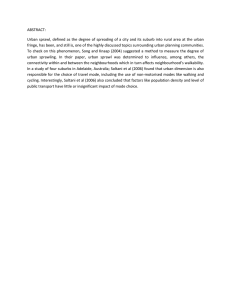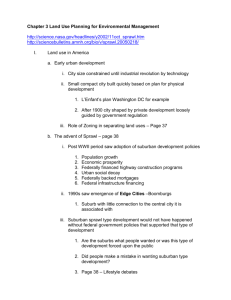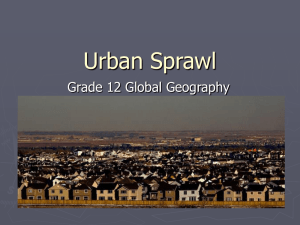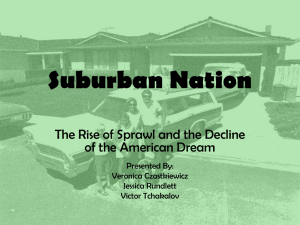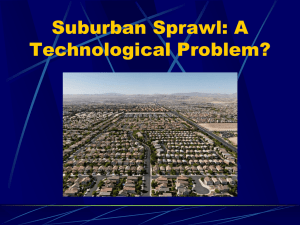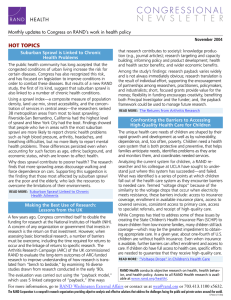Lecture 23
advertisement
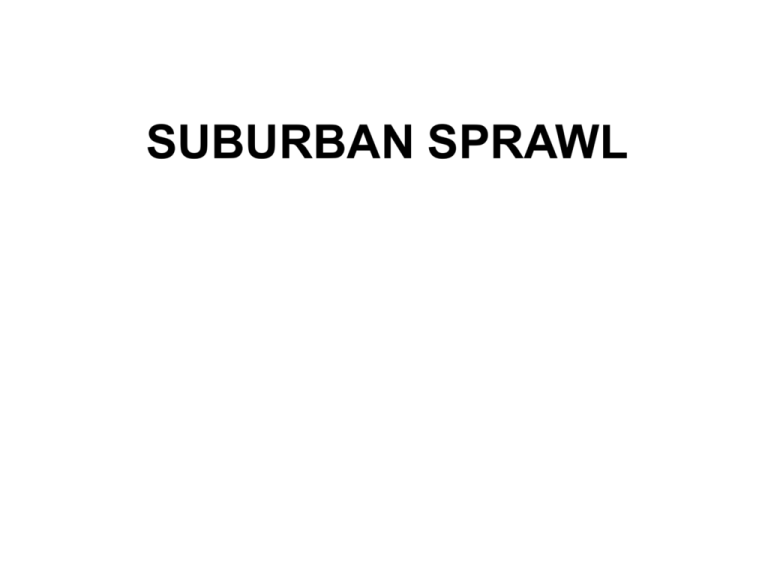
SUBURBAN SPRAWL What Causes it? 1. 2. 3. 4. 5. 6. 7. White flight Technology Government subsidizes Space/Land/Entropy Personal Preferences Government Policies Media America’s enduring romance with the automobile From the dawn of the automobile age, government has provided the right of way for cars, trucks, and buses, investing billions of dollars in highways, streets, traffic controls, and other essential infrastructure There is tremendous political appeal of the automobile, derived primarily from the enhancement of personal mobility and freedom of movement. There is a critical interplay between automotive transport and urban development that created the sprawling low-density contemporary metropolis, an urban form utterly dependent on automobile and highway serving a population that resists efforts to limit freedom of movement or increase the costs of automotive use. • Perhaps critics overestimate the dangers of sprawling urban development and global warming; they often promote expensive and inefficient rail transit schemes; and they propose land use and travel regulations that are antithetical to the American ideals of freedom and mobility. Fear and Loathing in Las Vegas (suburbs) • Avila discusses the “physical and cultural boundaries that distinguish white space from black space” • Does this distinction still exist today? • San Fernando Valley example • Perhaps the culture of white flight is over • White institutions are now becoming diversified – Sports – Media – Walt Disney: Mulan, Pocahontas • Avila - Growing frustration with the freeway and the automobile. The age of the freeway maybe passing What to do about sprawl? • Nothing? – as population grows people will fill out the surrounding area. First with low density building but later with higher density (edge cities) Calthorpe and Fulton • Planning (designing) • “Whole systems” approach • “the real illusion…is that we cannot control the form of our communities. • “the problem is not that our suburbs and cities are lacking design but that they are designed according to failed principles with flawed implementation. What are the failed principles?: 1. Specialization 2. Standardization 3. Mass Production • Specialization meant that each land useresidential, retail, commercial, or civic-was isolated and developed in isolation without any responsibility for the “whole.” • Standardization refers the “one size fits all” mentality. • Mass production – the logic of mass production moves relentlessly toward ever-increasing scales, which in turn reinforces the specialization and standardization. Is sprawl that bad? • “People uniformly long for an architecture that puts detail and identity back into what have too often become generic, if functional, buildings. • Siegel: “But sprawl brings enormous benefits and is in part an expression of the new high-tech economy whose campuslike office parks on the periphery of urban areas have driven the economic boom. • Rising income and employment, combined with declining interest rates, have allowed a record number of people (including minorities) to purchase homes for the first time, reflecting upward mobility for the aspiring lower middle class • Suburban growth can also help the central city. In the Philadelphia area, economic growth in the surrounding area helped offset the job losses in the city by creating new industries. 20 percent of the city residents commute to the suburbs. Hayden: New Urbanism (planned sprawl) • • • • No more housing subdivisions No more shopping centers No more office parks Solution: new suburban neighborhood with a master plan, tight building codes, narrow streets, attractive public places, and dedicated open spaces. • Seaside, Florida – Extended porch-sitting – Leisurely strolling – sidewalks!!!!! – No lawns? – Small lots – High density – HOA – 300 houses and few full-time residents

